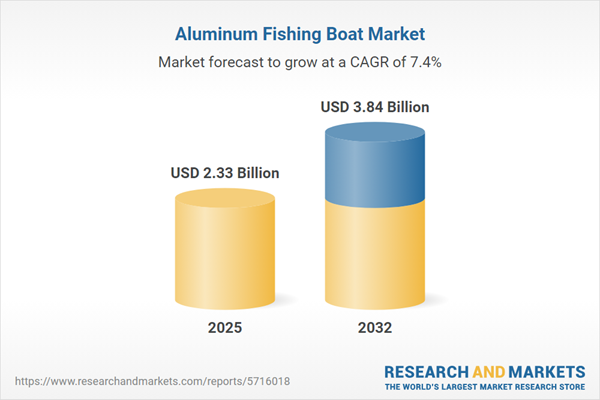Speak directly to the analyst to clarify any post sales queries you may have.
The aluminum fishing boat market is transforming as new materials, digital innovations, and evolving regulatory frameworks challenge traditional boating paradigms. Senior leaders seeking to optimize operations or diversify portfolios will find this sector characterized by agility, advanced engineering, and robust global demand.
Market Snapshot: Growth Trajectory in the Aluminum Fishing Boat Market
The Aluminum Fishing Boat Market grew from USD 2.17 billion in 2024 to USD 2.33 billion in 2025. It is expected to continue expanding at a CAGR of 7.36%, reaching USD 3.84 billion by 2032. Stakeholders can anticipate an upward market trajectory driven by increasing adoption of next-generation materials, innovation in propulsion systems, and heightened focus on user-centric onboard technologies. Demand remains propelled by both commercial and recreational users, with substantial opportunities to adapt offerings to changing consumer and regulatory priorities across global regions.
Scope & Segmentation
- End User Type: Commercial (charter services, patrol boats, research vessels); Recreational (leisure boating, sport fishing)
- Boat Length Category: Under 20 feet, 20–30 feet, above 30 feet
- Engine Type: Inboard, inboard outboard, outboard
- Distribution Channel: Dealership (authorized and independent dealers), direct sales (manufacturer outlets, OEM direct), online sales
- Price Range: Economy, mid-range, premium, ultra-premium
- Hull Design: Catamaran (twin hull), monohull (deep V hull, flat bottom hull)
- Regional Coverage: Americas (United States, Canada, Mexico, Brazil, Argentina, Chile, Colombia, Peru), Europe, Middle East & Africa (United Kingdom, Germany, France, Russia, Italy, Spain, Netherlands, Sweden, Poland, Switzerland, United Arab Emirates, Saudi Arabia, Qatar, Turkey, Israel, South Africa, Nigeria, Egypt, Kenya), Asia-Pacific (China, India, Japan, Australia, South Korea, Indonesia, Thailand, Malaysia, Singapore, Taiwan)
- Key Players: Tracker Marine Group, Ranger Boats, Crestliner, Lund Boat Company, G3 Boat Company, Lowe Boats, Alumacraft, SeaArk Products, MirroCraft, Sylvan Marine
Key Takeaways for Senior Decision-Makers
- Lightweight fabrication and digital integration are central to current vessel design strategies, supporting improved operational efficiency and enhanced user experience.
- Investments in hybrid propulsion and electric drive options are accelerating, directly responding to sustainability objectives and shifting regulatory landscapes.
- Emerging customer preferences highlight growing demand for modular layouts, custom storage, and advanced navigation, moving beyond traditional performance metrics.
- Global market dynamics require tailored go-to-market strategies, with North America and Europe favoring established distribution networks and emerging regions offering substantial growth potential through infrastructure investment.
- Manufacturer competition centers on advanced material applications, strategic partnerships, and differentiated aftersales support—critical for maintaining relevance in both established and developing markets.
- Segmented offerings by vessel length, hull type, and ownership model open further paths to address evolving buyer requirements across commercial and recreational spheres.
Tariff Impact: Navigating 2025 US Aluminum Import Duties
US-imposed 10% aluminum tariffs in 2025 have prompted significant supply chain adaptation among manufacturers. Many producers are revising procurement strategies, pursuing non-US suppliers, and considering nearshoring or final assembly shifts to mitigate increased input costs. These changes drive a renewed emphasis on operational flexibility and supply resilience. Firms are exploring vertical integration opportunities and process automations to offset tariff-related profitability pressures and sustain growth initiatives in the region.
Research Methodology & Data Sources
This report applies a rigorous hybrid methodology, blending qualitative interviews with industry executives and quantitative evaluation of trade flows, certification data, and market trends. Multi-source triangulation and expert feedback refine all major insights. Methodical secondary source validation ensures robust, actionable results that eliminate informational bias.
Why This Report Matters
- Supports critical investment, sourcing, and partnership decisions with clear segmentation and regional insights, directly relevant for executive strategy teams.
- Enables proactive risk mitigation through in-depth analysis of trade regulations, sustainability imperatives, and evolving consumer preferences.
- Equips businesses to identify tactical and strategic market entry points by mapping competitive positioning and technology integration outcomes.
Conclusion
The aluminum fishing boat industry is undergoing accelerated evolution, shaped by innovation and shifting global priorities. Success will rely on responsive strategies that blend advanced engineering, robust channel management, and a strong focus on sustainability. Leaders leveraging insights from this report will be positioned to drive resilient, forward-looking growth.
Additional Product Information:
- Purchase of this report includes 1 year online access with quarterly updates.
- This report can be updated on request. Please contact our Customer Experience team using the Ask a Question widget on our website.
Table of Contents
3. Executive Summary
4. Market Overview
7. Cumulative Impact of Artificial Intelligence 2025
Companies Mentioned
The companies profiled in this Aluminum Fishing Boat market report include:- Tracker Marine Group, LLC
- Ranger Boats, Inc.
- Crestliner, LLC
- Lund Boat Company, LLC
- G3 Boat Company, LLC
- Lowe Boats, Inc.
- Alumacraft, LLC
- SeaArk Products, LLC
- MirroCraft, Inc.
- Sylvan Marine, Inc.
Table Information
| Report Attribute | Details |
|---|---|
| No. of Pages | 185 |
| Published | October 2025 |
| Forecast Period | 2025 - 2032 |
| Estimated Market Value ( USD | $ 2.33 Billion |
| Forecasted Market Value ( USD | $ 3.84 Billion |
| Compound Annual Growth Rate | 7.3% |
| Regions Covered | Global |
| No. of Companies Mentioned | 11 |









